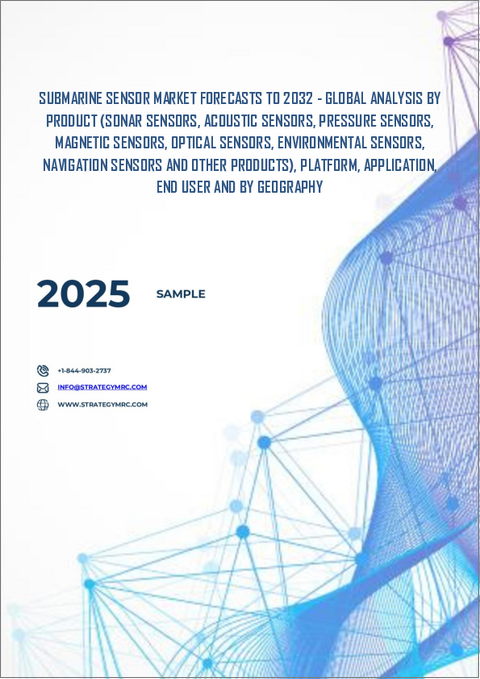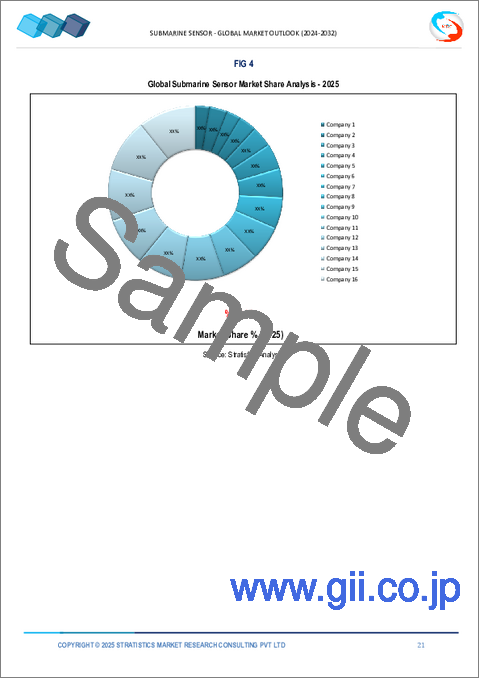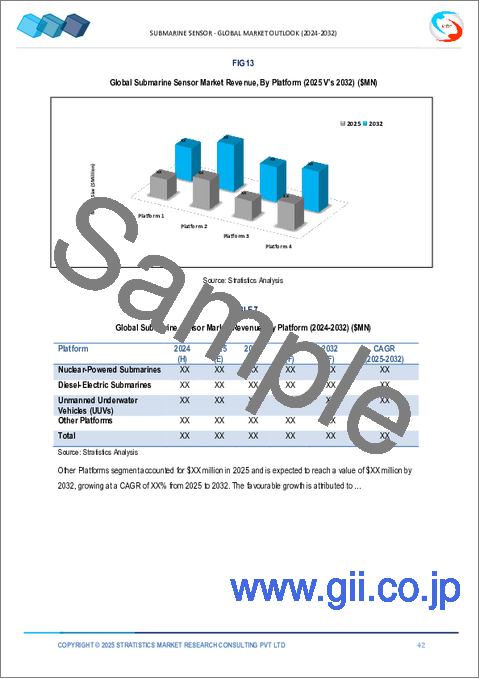|
|
市場調査レポート
商品コード
1662667
潜水艦センサ市場の2030年までの予測:製品別、プラットフォーム別、用途別、エンドユーザー別、地域別の世界分析Submarine Sensor Market Forecasts to 2030 - Global Analysis By Product, Platform, Application, End User and By Geography |
||||||
カスタマイズ可能
|
|||||||
| 潜水艦センサ市場の2030年までの予測:製品別、プラットフォーム別、用途別、エンドユーザー別、地域別の世界分析 |
|
出版日: 2025年02月02日
発行: Stratistics Market Research Consulting
ページ情報: 英文 200+ Pages
納期: 2~3営業日
|
全表示
- 概要
- 図表
- 目次
Stratistics MRCによると、世界の潜水艦センサ市場は2024年に3億300万米ドルを占め、予測期間中のCAGRは5.6%で成長し、2030年には3億9,950万米ドルに達する見込みです。
潜水艦センサは、水中環境からのデータを検出、モニタリング、解釈する特殊な装置であり、潜水艦の安全な運用に不可欠です。これらのセンサは、水中の厳しい条件下でも機能するように設計されており、環境変化や障害物をリアルタイムで検知することができます。これにより、ステルス操縦、危険回避、操作精度の維持が可能になります。潜水艦センサは、高圧、低照度、音響的に複雑な環境下でも確実に動作するように設計されています。これらのセンサは、航行、通信、科学探査、防衛活動などのタスクに貢献します。その性能は、潜水艦の安全性、効率性、有効性を維持するために不可欠であり、水中技術の不可欠な要素となっています。
地政学的緊張と海洋紛争
領土紛争に対処し、海上国境を守るため、各国はますます海軍能力の近代化を優先するようになっています。潜水艦センサは、水中の脅威を探知・追跡し、国家の安全を確保する上で重要な役割を果たしています。対潜水艦戦への注目の高まりは、センサ技術への投資をさらに促進しています。この動向は、進化する安全保障課題への対応における先進的探知・航行システムの重要性を浮き彫りにし、市場の成長を後押ししています。
高い開発・配備コスト
潜水艦センサの開発と配備には多額のコストがかかるため、小規模な海軍部隊や予算に制約のある海軍部隊での採用は限られています。これらの技術は、水中での運用に必要な性能基準を確実に満たすために、研究開発に多額の投資を必要とします。また、特殊な材料や精密工学が必要なため、製造コストも高くなります。さらに、保守や既存の潜水艦システムへの統合にかかるコストが高いため、財務上の課題もあります。これらの要因は、特に防衛予算が限られている地域において、市場の成長を抑制する要因となっています。
水中探査・調査需要の高まり
センサは海洋調査、水中考古学、資源マッピングに不可欠であり、非軍事用途での採用を促進しています。センサ技術の進歩により、研究者は気候変動研究や海洋生物多様性評価のためにより正確なデータにアクセスできます。政府や民間団体は深海探査に投資しており、革新的なセンサソリューションの需要をさらに押し上げています。水中調査への注目の高まりは、市場の拡大と多様化に有利な道を記載しています。
規制と輸出規制
防衛関連技術に対する規制や輸出制限は、潜水艦センサ市場に大きな課題を突きつけています。多くの国が機密機器の取引に厳しい規制を課しており、主要市場へのアクセスを制限しています。こうした規制はしばしば複雑な承認プロセスを伴い、取引を遅らせ、メーカーのコストを増大させています。また、輸出規制は国際的な利害関係者間の協力やパートナーシップの妨げにもなります。その結果、こうした制約が市場の世界的成長を鈍化させ、先端センサ技術の展開を制限する可能性があります。
COVID-19の影響
製造と調達は、労働力不足と物流の問題による課題に直面しました。こうした挫折にもかかわらず、パンデミックは海上安全保障と水中技術の重要性を浮き彫りにし、センサの進歩に対する関心の再燃につながりました。世界の防衛予算が回復し、焦点が戦略的近代化に戻るにつれて、潜水艦センサの需要は回復すると予想されます。同市場は、安全保障と調査の両方のニーズに対応するための先進システムに対する投資の増加によって、回復の態勢を整えています。
予測期間中、音響センサセグメントが最大になる見込み
音響センサセグメントは、低周波ソナーシステム、マルチスタティックソナーアレイ、AI駆動信号処理などの音響センサ技術の進歩により、探知範囲、精度、リアルタイムの意思決定能力を向上させるため、予測期間中に最大の市場シェアを占めると予想されます。音響センサは潜水艦センサ市場において極めて重要であり、水中探知と通信システムのバックボーンとしての役割を果たしています。低照度・高圧条件下で優れた性能を発揮するため、信頼性の高い選択肢として市場成長を牽引しています。
予測期間中、原子力潜水艦セグメントのCAGRが最も高い見込み
予測期間中、原子力潜水艦セグメントは、その耐久性、過酷な水中環境での継続的な運用のための長寿命センサにより、最も高い成長率を示すと予測されています。音響システムやナビゲーションシステムを含むこれらのセンサは、極端な圧力や温度変化に耐える必要があり、堅牢でエネルギー効率が高く、メンテナンスの少ない技術が必要とされます。これらのセンサに対する運用上の需要が高まっていることから、原子力潜水艦向けに特別に設計された、より堅牢でエネルギー効率が高く、メンテナンスが容易なセンサ技術の調査が進められています。
最大シェアの地域
予測期間中、北米地域は次世代潜水艦センサ技術の開発により最大の市場シェアを占めると予想され、米国海軍は先進ソナーシステムと音響センサに多額の投資を行っています。低周波ソナーシステムや水中通信技術などの高性能センサの需要は、センサメーカーに技術革新の機会をもたらしています。北米の研究機関や防衛請負業者は、潜水艦センサの能力を強化するためにAIを搭載した信号処理システムや機械学習アルゴリズムを開発しており、市場成長を促進しています。
CAGRが最も高い地域
予測期間中、アジア太平洋は、特に北米と欧州の地域大国と潜水艦センサメーカー間の協力や技術移転協定の急増により、最も高いCAGRを示すと予測されています。各国は艦隊の近代化に伴い、防衛技術の世界的リーダーから先進的なセンサシステムを求め、ノウハウや製造の専門知識を移転しています。こうした協力関係が潜水艦センサ市場の革新を促進し、潜水艦ソナー・フュージョンシステムや深海探査センサなど、この地域特有の運用環境に適した新技術を導入しています。
無料のカスタマイズ提供
本レポートをご購読の顧客には、以下の無料カスタマイズオプションのいずれかをご利用いただけます。
- 企業プロファイル
- 追加市場参入企業の包括的プロファイリング(3社まで)
- 主要企業のSWOT分析(3社まで)
- 地域セグメンテーション
- 顧客の関心に応じた主要国の市場推定・予測・CAGR(注:フィージビリティチェックによる)
- 競合ベンチマーキング
- 製品ポートフォリオ、地理的プレゼンス、戦略的提携による主要企業のベンチマーキング
目次
第1章 エグゼクティブサマリー
第2章 序文
- 概要
- ステークホルダー
- 調査範囲
- 調査手法
- データマイニング
- データ分析
- データ検証
- 調査アプローチ
- 調査情報源
- 1次調査情報源
- 2次調査情報源
- 前提条件
第3章 市場動向分析
- イントロダクション
- 促進要因
- 抑制要因
- 機会
- 脅威
- 製品分析
- 用途分析
- エンドユーザー分析
- 新興市場
- COVID-19の影響
第4章 ポーターのファイブフォース分析
- 供給企業の交渉力
- 買い手の交渉力
- 代替品の脅威
- 新規参入業者の脅威
- 競争企業間の敵対関係
第5章 世界の潜水艦センサ市場:製品別
- イントロダクション
- ソナーセンサ
- 音響センサ
- 圧力センサ
- 磁気センサ
- 光学センサ
- 環境センサ
- ナビゲーションセンサ
- その他
第6章 世界の潜水艦センサ市場:プラットフォーム別
- イントロダクション
- 原子力潜水艦
- 攻撃型潜水艦(SSN)
- 弾道ミサイル潜水艦(SSBN)
- ディーゼル電気潜水艦
- 無人潜水艇(UUV)
- 自律型水中探査機(AUV)
- 遠隔操作型無人探査機(ROV)
- その他
第7章 世界の潜水艦センサ市場:用途別
- イントロダクション
- モニタリングとモニタリング
- 対象認識と分類
- ナビゲーションとポジショニング
- 海洋学研究
- 水中通信
- その他
第8章 世界の潜水艦センサ市場:エンドユーザー別
- イントロダクション
- 海軍
- 研究機関
- 商業企業
- 海事組織
- その他
第9章 世界の潜水艦センサ市場:地域別
- イントロダクション
- 北米
- 米国
- カナダ
- メキシコ
- 欧州
- ドイツ
- 英国
- イタリア
- フランス
- スペイン
- その他の欧州
- アジア太平洋
- 日本
- 中国
- インド
- オーストラリア
- ニュージーランド
- 韓国
- その他のアジア太平洋
- 南米
- アルゼンチン
- ブラジル
- チリ
- その他の南米
- 中東・アフリカ
- サウジアラビア
- アラブ首長国連邦
- カタール
- 南アフリカ
- その他の中東・アフリカ
第10章 主要開発
- 契約、パートナーシップ、コラボレーション、合弁事業
- 買収と合併
- 新製品発売
- 事業拡大
- その他の主要戦略
第11章 企業プロファイリング
- Atlas Elektronik
- DRS Technologies
- Ducommun Incorporated
- Harris
- L3 KEO
- Leonardo DRS
- Lockheed Martin
- Northrop Grumman
- Raytheon
- Safran Electronics & Defense
- Thales Group
List of Tables
- Table 1 Global Submarine Sensor Market Outlook, By Region (2022-2030) ($MN)
- Table 2 Global Submarine Sensor Market Outlook, By Product (2022-2030) ($MN)
- Table 3 Global Submarine Sensor Market Outlook, By Sonar Sensors (2022-2030) ($MN)
- Table 4 Global Submarine Sensor Market Outlook, By Acoustic Sensors (2022-2030) ($MN)
- Table 5 Global Submarine Sensor Market Outlook, By Pressure Sensors (2022-2030) ($MN)
- Table 6 Global Submarine Sensor Market Outlook, By Magnetic Sensors (2022-2030) ($MN)
- Table 7 Global Submarine Sensor Market Outlook, By Optical Sensors (2022-2030) ($MN)
- Table 8 Global Submarine Sensor Market Outlook, By Environmental Sensors (2022-2030) ($MN)
- Table 9 Global Submarine Sensor Market Outlook, By Navigation Sensors (2022-2030) ($MN)
- Table 10 Global Submarine Sensor Market Outlook, By Other Products (2022-2030) ($MN)
- Table 11 Global Submarine Sensor Market Outlook, By Platform (2022-2030) ($MN)
- Table 12 Global Submarine Sensor Market Outlook, By Nuclear-Powered Submarines (2022-2030) ($MN)
- Table 13 Global Submarine Sensor Market Outlook, By Attack Submarines (SSN) (2022-2030) ($MN)
- Table 14 Global Submarine Sensor Market Outlook, By Ballistic Missile Submarines (SSBN) (2022-2030) ($MN)
- Table 15 Global Submarine Sensor Market Outlook, By Diesel-Electric Submarines (2022-2030) ($MN)
- Table 16 Global Submarine Sensor Market Outlook, By Unmanned Underwater Vehicles (UUVs) (2022-2030) ($MN)
- Table 17 Global Submarine Sensor Market Outlook, By Autonomous Underwater Vehicles (AUVs) (2022-2030) ($MN)
- Table 18 Global Submarine Sensor Market Outlook, By Remotely Operated Vehicles (ROVs) (2022-2030) ($MN)
- Table 19 Global Submarine Sensor Market Outlook, By Other Platforms (2022-2030) ($MN)
- Table 20 Global Submarine Sensor Market Outlook, By Application (2022-2030) ($MN)
- Table 21 Global Submarine Sensor Market Outlook, By Surveillance & Monitoring (2022-2030) ($MN)
- Table 22 Global Submarine Sensor Market Outlook, By Target Recognition & Classification (2022-2030) ($MN)
- Table 23 Global Submarine Sensor Market Outlook, By Navigation & Positioning (2022-2030) ($MN)
- Table 24 Global Submarine Sensor Market Outlook, By Oceanographic Research (2022-2030) ($MN)
- Table 25 Global Submarine Sensor Market Outlook, By Underwater Communication (2022-2030) ($MN)
- Table 26 Global Submarine Sensor Market Outlook, By Other Applications (2022-2030) ($MN)
- Table 27 Global Submarine Sensor Market Outlook, By End User (2022-2030) ($MN)
- Table 28 Global Submarine Sensor Market Outlook, By Naval Forces (2022-2030) ($MN)
- Table 29 Global Submarine Sensor Market Outlook, By Research Institutions (2022-2030) ($MN)
- Table 30 Global Submarine Sensor Market Outlook, By Commercial Enterprises (2022-2030) ($MN)
- Table 31 Global Submarine Sensor Market Outlook, By Maritime Organizations (2022-2030) ($MN)
- Table 32 Global Submarine Sensor Market Outlook, By Other End Users (2022-2030) ($MN)
Note: Tables for North America, Europe, APAC, South America, and Middle East & Africa Regions are also represented in the same manner as above.
According to Stratistics MRC, the Global Submarine Sensor Market is accounted for $303.0 million in 2024 and is expected to reach $399.5 million by 2030 growing at a CAGR of 5.6% during the forecast period. A submarine sensor is a specialized device that detects, monitors, and interprets data from the underwater environment, crucial for a submarine's safe operation. These sensors are designed to function in challenging underwater conditions, enabling real-time detection of environmental changes and obstacles. They enable stealthily manoeuvring, avoiding hazards, and maintaining operational precision. Submarine sensors are engineered to work reliably under high pressure, low light, and acoustically complex environments. They contribute to tasks such as navigation, communication, scientific exploration, and defense operations. Their performance is vital for maintaining a submarine's safety, efficiency, and effectiveness, making them an essential component of underwater technology.
Market Dynamics:
Driver:
Geopolitical tensions and maritime conflicts
Nations are increasingly prioritizing the modernization of naval capabilities to address territorial disputes and protect maritime borders. Submarine sensors play a critical role in detecting and tracking underwater threats, ensuring national security. The heightened focus on anti-submarine warfare has further propelled investments in sensor technologies. This trend underscores the importance of sophisticated detection and navigation systems in addressing evolving security challenges boosts the market growth.
Restraint:
High development and deployment costs
Development and deployment of submarine sensors involve substantial costs, limiting their adoption by smaller or budget-constrained naval forces. These technologies require significant investments in R&D to ensure they meet the performance standards for underwater operations. Manufacturing costs are also elevated due to the need for specialized materials and precision engineering. Additionally, the high costs of maintenance and integration into existing submarine systems pose financial challenges. These factors collectively restrain market growth, particularly in regions with limited defense budgets.
Opportunity:
Growing demand for underwater exploration and research
Sensors are vital for oceanographic studies, underwater archaeology, and resource mapping, driving their adoption in non-military applications. With advancements in sensor technology, researchers can access more accurate data for climate change studies and marine biodiversity assessments. Governments and private entities are investing in deep-sea exploration, further boosting demand for innovative sensor solutions. This growing focus on underwater research offers a lucrative avenue for market expansion and diversification.
Threat:
Regulatory and export restrictions
Regulatory and export restrictions on defense-related technologies pose a significant challenge to the submarine sensor market. Many countries impose strict controls on the trade of sensitive equipment, limiting access to key markets. These regulations often involve complex approval processes, delaying transactions and increasing costs for manufacturers. Export restrictions can also hinder collaborations and partnerships between international stakeholders. As a result, such constraints may slow down the market's global growth and restrict the deployment of advanced sensor technologies.
Covid-19 Impact
Manufacturing and procurement faced challenges due to workforce shortages and logistical issues. Despite these setbacks, the pandemic underscored the importance of maritime security and underwater technologies, leading to renewed interest in sensor advancements. As global defense budgets recover and focus shifts back to strategic modernization, the demand for submarine sensors is expected to rebound. The market is poised for recovery, driven by increased investments in advanced systems to address both security and research needs.
The acoustic sensors segment is expected to be the largest during the forecast period
The acoustic sensors segment is expected to account for the largest market share during the forecast period owing to advancements in acoustic sensor technologies, such as low-frequency sonar systems, multistatic sonar arrays, and AI-driven signal processing, which enhances detection range, accuracy, and real-time decision-making capabilities. Acoustic sensors are crucial in the submarine sensor market, serving as the backbone of underwater detection and communication systems. Their superior performance in low-light and high-pressure conditions makes them a reliable choice driving the market growth.
The nuclear-powered submarines segment is expected to have the highest CAGR during the forecast period
Over the forecast period, the nuclear-powered submarines segment is predicted to witness the highest growth rate owing to their durability, and long-lasting sensors for continuous operation in harsh underwater environments. These sensors, including acoustic and navigation systems, must withstand extreme pressure and temperature variations, requiring robust, energy-efficient, and low-maintenance technologies. The growing operational demand for these sensors is driving research into more robust, energy-efficient, and low-maintenance sensor technologies specifically designed for nuclear submarines.
Region with largest share:
During the forecast period, the North America region is expected to hold the largest market share due to developing next-generation submarine sensor technologies, with the U.S. Navy investing heavily in advanced sonar systems and acoustic sensors. The demand for high-performance sensors, such as low-frequency sonar systems and underwater communication technologies, is creating opportunities for sensor manufacturers to innovate. Research institutions and defense contractors in North America are developing AI-powered signal processing systems and machine learning algorithms to enhance submarine sensor capabilities, driving market growth.
Region with highest CAGR:
Over the forecast period, the Asia Pacific region is anticipated to exhibit the highest CAGR owing to the surge in collaborations and technology transfer agreements between regional powers and submarine sensor manufacturers, particularly those in North America and Europe. As nations modernize their fleets, they seek advanced sensor systems from global leaders in defense technology, transferring know-how and manufacturing expertise. These collaborations foster innovation in the submarine sensor market, introducing new technologies suited to the region's unique operational environments, such as submarine sonar fusion systems and deep-sea exploration sensors.
Key players in the market
Some of the key players in Submarine Sensor market include Atlas Elektronik, DRS Technologies, Ducommun Incorporated, Harris, L3 KEO, Leonardo DRS, Lockheed Martin, Northrop Grumman, Raytheon, Safran Electronics & Defense and Thales Group .
Key Developments:
In January 2025, Lockheed martin announced new Skunk Works(R), integrated fighter leaders. With their combined experience, OJ and Mike will work closely together and with our broader team to drive innovation and strategy across platforms, across Aeronautics and across the corporation.
In December 2024, Lockheed Martin has announced the formation of Astris AI, a subsidiary focused on enabling the adoption of artificial intelligence (AI) solutions across the U.S. defense industrial base and commercial industry sectors that have high assurance requirements.
In December 2024, Northrop Grumman Corporation launched a Zombie target vehicle variation, known as "Black Dagger," from Fort Wingate to White Sands Missile Range, New Mexico, for the U.S. Army Space and Missile Defense Command's LTZ-3 test mission.
Products Covered:
- Sonar Sensors
- Acoustic Sensors
- Pressure Sensors
- Magnetic Sensors
- Optical Sensors
- Environmental Sensors
- Navigation Sensors
- Other Products
Platforms Covered:
- Nuclear-Powered Submarines
- Diesel-Electric Submarines
- Unmanned Underwater Vehicles (UUVs)
- Other Platforms
Applications Covered:
- Surveillance & Monitoring
- Target Recognition & Classification
- Navigation & Positioning
- Oceanographic Research
- Underwater Communication
- Other Applications
End Users Covered:
- Naval Forces
- Research Institutions
- Commercial Enterprises
- Maritime Organizations
- Other End Users
Regions Covered:
- North America
- US
- Canada
- Mexico
- Europe
- Germany
- UK
- Italy
- France
- Spain
- Rest of Europe
- Asia Pacific
- Japan
- China
- India
- Australia
- New Zealand
- South Korea
- Rest of Asia Pacific
- South America
- Argentina
- Brazil
- Chile
- Rest of South America
- Middle East & Africa
- Saudi Arabia
- UAE
- Qatar
- South Africa
- Rest of Middle East & Africa
What our report offers:
- Market share assessments for the regional and country-level segments
- Strategic recommendations for the new entrants
- Covers Market data for the years 2022, 2023, 2024, 2026, and 2030
- Market Trends (Drivers, Constraints, Opportunities, Threats, Challenges, Investment Opportunities, and recommendations)
- Strategic recommendations in key business segments based on the market estimations
- Competitive landscaping mapping the key common trends
- Company profiling with detailed strategies, financials, and recent developments
- Supply chain trends mapping the latest technological advancements
Free Customization Offerings:
All the customers of this report will be entitled to receive one of the following free customization options:
- Company Profiling
- Comprehensive profiling of additional market players (up to 3)
- SWOT Analysis of key players (up to 3)
- Regional Segmentation
- Market estimations, Forecasts and CAGR of any prominent country as per the client's interest (Note: Depends on feasibility check)
- Competitive Benchmarking
- Benchmarking of key players based on product portfolio, geographical presence, and strategic alliances
Table of Contents
1 Executive Summary
2 Preface
- 2.1 Abstract
- 2.2 Stake Holders
- 2.3 Research Scope
- 2.4 Research Methodology
- 2.4.1 Data Mining
- 2.4.2 Data Analysis
- 2.4.3 Data Validation
- 2.4.4 Research Approach
- 2.5 Research Sources
- 2.5.1 Primary Research Sources
- 2.5.2 Secondary Research Sources
- 2.5.3 Assumptions
3 Market Trend Analysis
- 3.1 Introduction
- 3.2 Drivers
- 3.3 Restraints
- 3.4 Opportunities
- 3.5 Threats
- 3.6 Product Analysis
- 3.7 Application Analysis
- 3.8 End User Analysis
- 3.9 Emerging Markets
- 3.10 Impact of Covid-19
4 Porters Five Force Analysis
- 4.1 Bargaining power of suppliers
- 4.2 Bargaining power of buyers
- 4.3 Threat of substitutes
- 4.4 Threat of new entrants
- 4.5 Competitive rivalry
5 Global Submarine Sensor Market, By Product
- 5.1 Introduction
- 5.2 Sonar Sensors
- 5.3 Acoustic Sensors
- 5.4 Pressure Sensors
- 5.5 Magnetic Sensors
- 5.6 Optical Sensors
- 5.7 Environmental Sensors
- 5.8 Navigation Sensors
- 5.9 Other Products
6 Global Submarine Sensor Market, By Platform
- 6.1 Introduction
- 6.2 Nuclear-Powered Submarines
- 6.2.1 Attack Submarines (SSN)
- 6.2.2 Ballistic Missile Submarines (SSBN)
- 6.3 Diesel-Electric Submarines
- 6.4 Unmanned Underwater Vehicles (UUVs)
- 6.4.1 Autonomous Underwater Vehicles (AUVs)
- 6.4.2 Remotely Operated Vehicles (ROVs)
- 6.5 Other Platforms
7 Global Submarine Sensor Market, By Application
- 7.1 Introduction
- 7.2 Surveillance & Monitoring
- 7.3 Target Recognition & Classification
- 7.4 Navigation & Positioning
- 7.5 Oceanographic Research
- 7.6 Underwater Communication
- 7.7 Other Applications
8 Global Submarine Sensor Market, By End User
- 8.1 Introduction
- 8.2 Naval Forces
- 8.3 Research Institutions
- 8.4 Commercial Enterprises
- 8.5 Maritime Organizations
- 8.6 Other End Users
9 Global Submarine Sensor Market, By Geography
- 9.1 Introduction
- 9.2 North America
- 9.2.1 US
- 9.2.2 Canada
- 9.2.3 Mexico
- 9.3 Europe
- 9.3.1 Germany
- 9.3.2 UK
- 9.3.3 Italy
- 9.3.4 France
- 9.3.5 Spain
- 9.3.6 Rest of Europe
- 9.4 Asia Pacific
- 9.4.1 Japan
- 9.4.2 China
- 9.4.3 India
- 9.4.4 Australia
- 9.4.5 New Zealand
- 9.4.6 South Korea
- 9.4.7 Rest of Asia Pacific
- 9.5 South America
- 9.5.1 Argentina
- 9.5.2 Brazil
- 9.5.3 Chile
- 9.5.4 Rest of South America
- 9.6 Middle East & Africa
- 9.6.1 Saudi Arabia
- 9.6.2 UAE
- 9.6.3 Qatar
- 9.6.4 South Africa
- 9.6.5 Rest of Middle East & Africa
10 Key Developments
- 10.1 Agreements, Partnerships, Collaborations and Joint Ventures
- 10.2 Acquisitions & Mergers
- 10.3 New Product Launch
- 10.4 Expansions
- 10.5 Other Key Strategies
11 Company Profiling
- 11.1 Atlas Elektronik
- 11.2 DRS Technologies
- 11.3 Ducommun Incorporated
- 11.4 Harris
- 11.5 L3 KEO
- 11.6 Leonardo DRS
- 11.7 Lockheed Martin
- 11.8 Northrop Grumman
- 11.9 Raytheon
- 11.10 Safran Electronics & Defense
- 11.11 Thales Group






